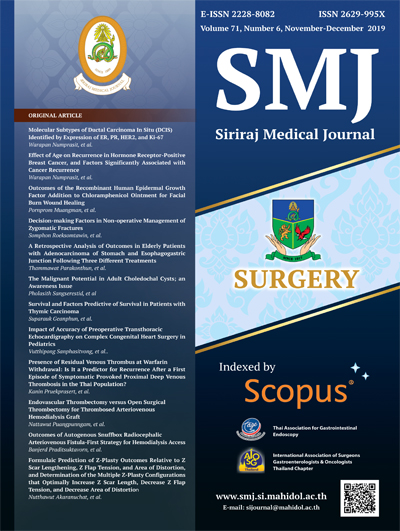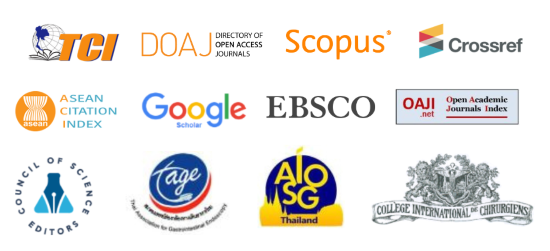Retrospective Analysis of the Outcomes in Elderly Patients with Adenocarcinoma of the Stomach and Esophagogastric Junction Following Three Different Treatments
DOI:
https://doi.org/10.33192/Smj.2019.68Keywords:
Stomach neoplasms; gastrectomy; aged; mortality; esophagogastric junctionAbstract
Objective: To compare survival outcomes and complications in elderly patients who underwent three different treatments.
Methods: The data of patients aged 70 years old or older diagnosed with adenocarcinoma of the stomach and esophagogastric junction (Siewert types II and III) between January 2005 and December 2016 were reviewed. The results of different treatments and risk factors for post-treatment morbidity and mortality were analyzed.
Results: In total, 220 elderly patients were included: 102 (46.4%) who underwent curative intended gastrectomy with radical lymphadenectomy (Curative group), 62 (28.2%) who underwent non-curative surgery or endoscopy (Non-curative group), and 56 (25.4%) who received best supportive care (BSC group). Mean ages were 76.6, 78.1, and 78.7 years old, respectively (p=0.596). Median overall survival was 32, 5, and 3 months, respectively (p<0.001). In the curative group, overall survival was associated with the pathological stage (p=0.017), but not the resection category (p=0.298). Concerning the curative and non-curative groups, severe post-treatment complications occurred in 14 (8.5%) patients (7.8%, curative group; 9.7%, non-curative group). Severe post-treatment complication was associated with age ≥80 years (p=0.023) and coronary artery disease (p<0.001); however, multivariate analysis identified coronary artery disease as an independent risk factor for severe post-treatment complication. 5 (3%) patients had in-hospital mortality, associated with age ≥80 years old (p=0.039) and coronary artery disease (p=0.005).
Conclusion: Curative and non-curative procedures can be safely performed in elderly patients. However, caution should be taken with extreme elderly patients, especially those with coronary artery disease. Best supportive care should be considered only for unfit patients.
Downloads
Published
How to Cite
Issue
Section
License
Users are free to share, copy, and redistribute all articles published in the Siriraj Medical Journal (SMJ) in any medium or format as long as you follow the following terms:
- Attribution — You must give appropriate credit, provide a link to the material, and indicate if changes were made. You may do so in any reasonable manner, but not in any way that suggests the publisher endorses you or your use.
- NonCommercial — You may not use the material for commercial purposes.
- NoDerivatives — If you remix, transform, or build upon the material, you may not distribute the modified material.
- No additional restrictions — You may not apply legal terms or technological measures that legally restrict others from doing anything the license permits.











